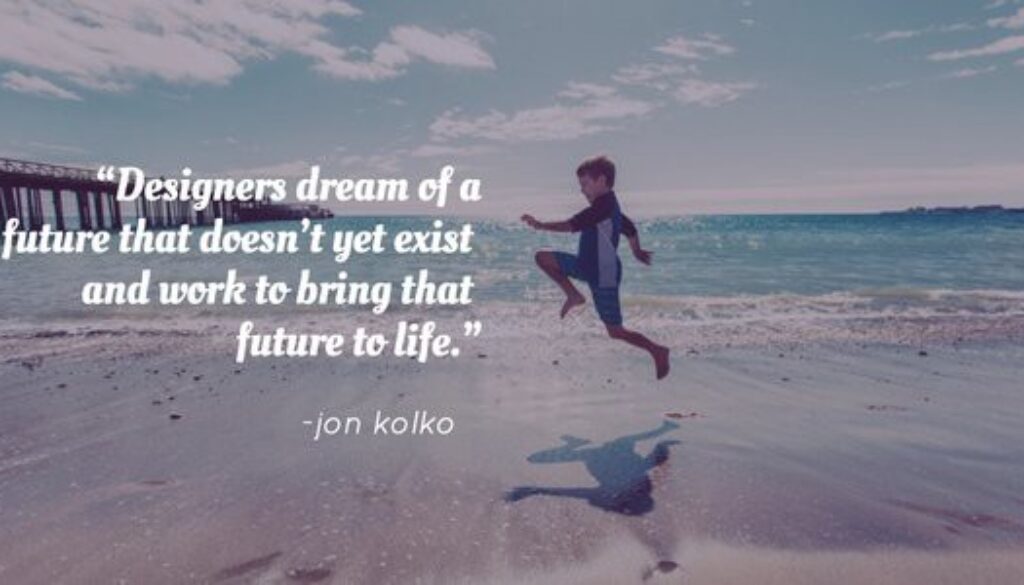3 Simple Tricks to Train Yourself to Be More Optimistic
I am what some people might call “relentlessly optimistic.” It’s pretty hard to get me down, and I get really excited when I have the chance to brainstorm improvements, execute on new ideas, or dream up a hare-brained scheme.
I might be a marketer by trade, but this level of optimism — a focus on a future that holds something bigger or better than today — is something I share in common with most other creatives. Jon Kolko, founder of the Austin Center for Design, said, “Designers dream of a future that doesn’t yet exist and work to bring that future to life.”
Optimism is also on IDEO’s Tim Brown’s list of design thinking characteristics. Whether the future looks like a particular gesture used to zoom in on a smartphone or a radical solution to global warming, design thinking and the optimism that comes with it are essential.
But maintaining an optimistic outlook isn’t always easy. We have deadlines to hit, briefs to meet, and stakeholders to satisfy — which can leave little time for looking on the bright side. If you’re feeling the pull toward “glass-half-empty,” incorporate one or more of these exercises into your daily routine.
1. Keep a Gratitude Journal
Want to be more optimistic? Start with gratitude.
A 2003 study of the effect of a grateful outlook on physical and emotional well-being found something interesting: keeping a daily or weekly gratitude journal improved participants’ overall optimistic outlook.
Let’s hear that again. Keeping a daily or weekly gratitude journal improved participants’ overall optimistic outlook.
You could improve your overall optimistic outlook — on life — by keeping simple notes once a day or once a week on the good things in your life. (The frequency made an impact on the percent increase in optimism — 5% vs. 15%.)
This one makes intuitive sense: by giving thanks for the good things in our current life, we might be inclined to think positively about our future life, too.
2. Practice Looking for Multiple Outcomes
Optimism in creation means imagining multiple alternative futures rather than zeroing in on one “right solution.” If you struggle to broaden your mind during a project, set some time aside right at the start to let your mind wander over potential solutions.
In marketing, we spend a lot of time thinking about the perfect headline for our content. The headline makes a huge difference, after all — people frequently click, read, share, and promote content based on the headline alone.
One of the best ways to come up with a great headline is to brainstorm way more alternative headlines than you might think you need. Upworthy’s recipe for virality requires writing down at least 25 alternatives before choosing the best. I’ll tell you from experience — most marketers stop at one or two.
Imagine taking this principle into your creative work. What if, rather than stopping when you’d thought of a single elegant solution to your challenge, you kept going? You could jot cockamamie plan after hare-brained idea down in your notebook without anyone knowing. You don’t have to use any of those crazy ideas — but hidden in amongst the absurdity might be a better solution than you could have imagined.
Casting a wide net like this on a regular basis can train your brain to think more expansively — more optimistically — by allowing multiple solutions to coexist at once.
3. Take Daily Risks
Pessimism can sometimes look a lot like fear.
“That would never work.”
“I’ll never make this deadline.”
“We’re doomed.”
These are all different ways of expressing fear around a potential negative outcome.
Optimism, on the other hand, is typically linked with hope — and a belief in the possible. Mike Wiggins, Chair of the Art & Design department at Abilene Christian University, said, “After teaching for 12 years, I’ve started to think of good design as a tenacious optimism: the belief that a better solution is just over the next hill—or cliff.”
Successful creators take risks. Sometimes big risks, sometimes small. If you’re naturally risk-averse, there are ways to gradually increase your ability to take chances, both in your life and in your work.
If you need some inspiration, Riskology offers 27 small risks you could take every day to get in the habit of testing fate. Suggestions include “Publicly state your biggest goal (1 minute)” or “Show your art in public (90 minutes)”. Taking small risks over time will build up your ability to take bigger risks when you need to — and have a more optimistic outlook on the outcome.
Shift to Glass-Half-Full
Makers are in the business of building the future. Creating a future that no one’s ever seen requires an expansive kind of optimism and a willingness to consider myriad options.
While some people are naturally optimistic or pessimistic, you don’t have to play the hand you’re dealt. By shifting your daily habits toward the sunny side — in the form of gratitude, open-mindedness, and risk-taking — you can become more optimistic in the long-run.


May 2, 2016 @ 1:35 pm
Hey Lena,
Being optimistic is very challenging task for many because they always see the glass half empty. I consider myself optimistic and I don’t like negative and pessimistic people because it’s not my ideology.
I follow people like Robin Sharma, Brian Tracy, Sandeep Maheshwari etc who motivates me to be positive and trust my dreams.
I love TedEx talk videos they are entertaining and valuable.
Thanks